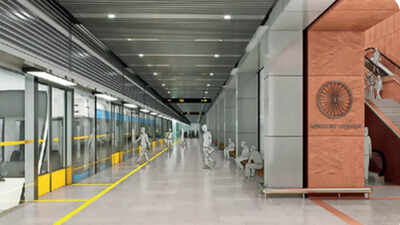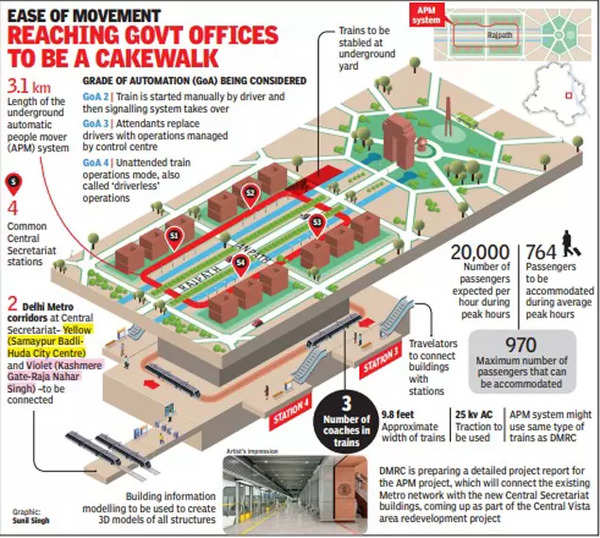Top Searches
- News
- City News
- delhi News
- Delhi: Driverless train for Central Vista loop corridor? plan set in motion
Delhi: Driverless train for Central Vista loop corridor? plan set in motion

The corridor will connect four common Central Secretariat buildings and will have an underground yard as well
NEW DELHI: The automatic people mover (APM) system that will connect the upcoming Central Secretariat buildings with the existing Central Secretariat Metro station as part of the Central Vista redevelopment project, may see ‘driverless’ trains operating on the more than 3-km-long loop corridor.

The underground APM system, which will have a total length of 3.1 km, will run in a closed loop and primarily meet transportation needs of government employees working in these buildings. The corridor will connect four common Central Secretariat buildings and will have an underground yard as well.
The system will be connected to the existing Metro network through an interchange station at Central Secretariat, which will provide integration with the Yellow (Samaypur Badli-HUDA City Centre) and Violet (Kashmere Gate-Raja Nahar Singh) Lines. A major aim behind the project is to reduce the need to commute to office using private vehicles.
Delhi Metro Rail Corporation (DMRC), which is preparing a detailed project report (DPR), has started the process for engaging a detailed design consultant for civil, architectural, and building services for the project.
The consultant, however, will also assist in finalising technical specifications of various systems, and design of trainway and stations. The capacity of the system and frequency of trains will be based on the expected peak hour demand of 20,000 passengers per hour during the morning and evening peak hours, according to the tender floated by DMRC.
The consultant will make presentations to DMRC and other stakeholders and submit a detailed report that will also examine the option of using trainsets already being used in Delhi Metro network. As per the document, the trains will have a three-coach configuration and the system will have a standard gauge, like all comparatively new Delhi Metro corridors. The trains will have to be wide enough to accommodate 764 to 970 passengers during peak hour conditions.
Train movement will be managed from an operation control centre (OCC) and grade of automation of the trains is likely to be at par with the new corridors of Delhi Metro.
A series of intensive workshops will also be held with all stakeholders to finalise the system parameters and technological specifications. These workshops will include discussions on the automation level to be adopted for operation of Central Vista line from GoA2, GoA3 or GoA4, apart from what type of evacuation to be adopted – from side or front of train. At GoA2 mode, the train is only started manually by the driver and from there on, it is taken over by the OCC, which controls everything from speed of train to stopping and opening of doors. In the next mode – GoA3 – drivers are replaced by roaming attendants. The GoA4 or unattended train operation mode is also known as ‘driverless’ train operation.

The underground APM system, which will have a total length of 3.1 km, will run in a closed loop and primarily meet transportation needs of government employees working in these buildings. The corridor will connect four common Central Secretariat buildings and will have an underground yard as well.
The system will be connected to the existing Metro network through an interchange station at Central Secretariat, which will provide integration with the Yellow (Samaypur Badli-HUDA City Centre) and Violet (Kashmere Gate-Raja Nahar Singh) Lines. A major aim behind the project is to reduce the need to commute to office using private vehicles.
Delhi Metro Rail Corporation (DMRC), which is preparing a detailed project report (DPR), has started the process for engaging a detailed design consultant for civil, architectural, and building services for the project.
The consultant, however, will also assist in finalising technical specifications of various systems, and design of trainway and stations. The capacity of the system and frequency of trains will be based on the expected peak hour demand of 20,000 passengers per hour during the morning and evening peak hours, according to the tender floated by DMRC.
The consultant will make presentations to DMRC and other stakeholders and submit a detailed report that will also examine the option of using trainsets already being used in Delhi Metro network. As per the document, the trains will have a three-coach configuration and the system will have a standard gauge, like all comparatively new Delhi Metro corridors. The trains will have to be wide enough to accommodate 764 to 970 passengers during peak hour conditions.
Train movement will be managed from an operation control centre (OCC) and grade of automation of the trains is likely to be at par with the new corridors of Delhi Metro.
A series of intensive workshops will also be held with all stakeholders to finalise the system parameters and technological specifications. These workshops will include discussions on the automation level to be adopted for operation of Central Vista line from GoA2, GoA3 or GoA4, apart from what type of evacuation to be adopted – from side or front of train. At GoA2 mode, the train is only started manually by the driver and from there on, it is taken over by the OCC, which controls everything from speed of train to stopping and opening of doors. In the next mode – GoA3 – drivers are replaced by roaming attendants. The GoA4 or unattended train operation mode is also known as ‘driverless’ train operation.
FOLLOW US ON SOCIAL MEDIA
FacebookTwitterInstagramKOO APPYOUTUBE
Looking for Something?

Start a Conversation
end of article

